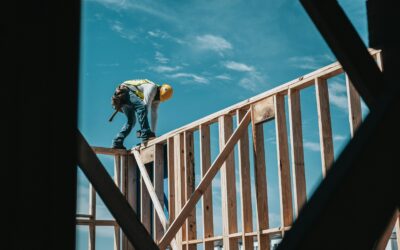A notable increase in demand for construction deliverables and labor combined has created a unique set of both opportunities and challenges for your construction clients. Covid-era consumer interest in homebuying is still trending above normal, and forecasts indicate 2022 will be a “whirlwind year” for the housing market.
This booming demand is colliding with worldwide supply chain conditions that make delivering on those projects—and on schedule, no less—particularly difficult. According to recent reports, “Production shortfalls are behind 75% of the current contraction in global trade volume, while logistic bottlenecks are the cause of the remaining 25%.” That shortage has contributed to steeper costs for what materials are available.
Even more immediately challenging as job requests come in is a “crisis-level” shortage in skilled workers in the construction sector, as it was reported that up to 400,000 open jobs in the industry needed filling as recently as November 2021. This puts an additional strain on laborers who may already be feeling mentally taxed after more than a year of above normal demand for their services during a pandemic, no less.
Fortunately, there are steps your clients can take to help reduce the strain on employees and prepare for this new reality—and steps you, as their broker, can take to support them.
Have a Plan for Recruitment
The worker shortage is widespread and therefore requires creative solutions to remedy. For context, 88% of contractors in Texas reported having unfilled positions. Construction leaders widely share that the lack of both skilled and unskilled workers is front of mind for most firms at present. For your clients, there is strength in numbers: joining community or industry organizations and initiatives fosters better visibility and awareness.
Many trade groups are reaching into local high schools to identify future talent, develop their interests, and provide early training. Additional initiatives are underway at a national and local level to drive more talent into the construction industry by reaching out to demographics such as young women who may have been overlooked. Attempting to organize these kinds of programs may be overwhelming for one firm alone, especially when there are already constraints on time and availability, so advise your clients to ask around at trade shows or inquire with organizations they may already belong to, such as the National Association for Homebuilders.

Make “Home Safe” a Priority
It’s no surprise that there is a correlation between employee mental health and workplace safety, across industries but especially when it comes to higher risk trades. Lean on your workers compensation insurance partners for resources to help laborers on the job recognize when they—or their colleagues—need to step away.
Foresight, through its exclusive partnership with the risk management technology of Safesite, provides numerous checklists, meeting guidelines, and much more to make sure safety remains the focus of your clients’ operations even in the busiest of economies. As a broker, ensuring you have access to insurers that are leveraging real-time information relevant to the industries your clients serve is a value-demonstrated service. A commitment to getting every worker home safe at the end of the workday should be a value shared by the client, broker, and insurance partner. Your client does not have to go it alone.
Recognize and Reward
Everyone wants to feel appreciated when they’ve been overdelivering. The dwindling time off between jobs coupled with demanding long hours are taxing. Something as simple as taking care of a meal for your client’s team can make a big difference. If your touchpoints and meetings are timed with visits to a job site, ask ahead if you can handle breakfast or lunch for the crew.
Your clients can go a step further by offering perks that are both cathartic and health-oriented. Companies can source a massage therapist to offer neck, shoulder, and back pain relief for multiple workers in the same day. As workplace wellbeing has become an increased focus in recent years, more businesses are also offering stipends for employee health and wellness on their own time. A stipend or reimbursement for a gym membership lets team members know that their health is a priority even when they aren’t on the job.

Make it Part of the Long-Term Culture
The supply shortage and labor crisis won’t dissipate overnight, so ensure your clients know that the resulting impacts will take time to solve for. As part of your due diligence with your clients, include construction worker stress in your regular meetings and keep it front of mind. Working together, we can collectively support workers in the construction industry even in trying economic times.



